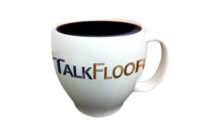Let’s TalkFloor
Zhong on Growing Domotex Asia/ChinaFloor to the World’s Biggest Show

Officials for VNU, the show’s organizer, said the 16th edition of DACF saw more than 42,000 people from over 100 countries, which would put it on track to become the world’s largest flooring trade show.

While the American consumer can pretty much walk into a single store and get all her decorating needs done, in China, home furnishings businesses are generally single product-type of establishments, and usually featuring products from just one company which either owns the store outright or franchises it to an entrepreneur.

While the American consumer can pretty much walk into a single store and get all her decorating needs done, in China, home furnishings businesses are generally single product-type of establishments, and usually featuring products from just one company which either owns the store outright or franchises it to an entrepreneur.

When it comes to shopping for home furnishings in China, consumers and designers generally have to go to large mall-like buildings such as this one in the heart of Shanghai.




If you haven’t had the chance to go to Domotex asia/ChinaFloor (DACF) you need to add it to your bucket list. I just had the opportunity to attend this show for the fifth time and I never cease to be amazed by the energy, the evolution and the innovation this event demonstrates each year.
This was the 16th version of the show and every year it appears to reinvent itself, starting in the early days as a vehicle for retailers, distributors, manufacturers and others from North American, Europe and elsewhere to source floor coverings at lower costs.
While this part of the show still remains as strong as ever, other elements have also provided substantial added growth. The rapid expansion of the Chinese middle class has stoked the growth of a burgeoning retail sector, adding thousands of attendees to the mix.
And not only is the middle class growing in China and across Asia, but commercial buildings of every description have been and are continuing to sprout up all over the region, bringing architects, designers, contractors and facility managers to the show. With more than 160 cities in China with populations of over one million, according to the magazine China Today, this growth doesn’t show any sign of tapering off any time soon.
And this is just China, DACF is truly an international show drawing attendees and exhibitors from the entire Asian Pacific region and around the world, with 1,122 exhibitors showing up last year, filling the Shanghai New International Exhibition Centre for a total of 1.4 million square feet of gross exhibit space.
This was the setting that prevailed when we had the opportunity to sit down on the morning of the second day of this three-day show with David Zhong, CEO of VNU Exhibitions Asia Pacific, the organizers of the show, and the person who dreamed up this event more than 16 years ago and launched it with Thomas Baert.
The following are some excerpts from the video interview of that conversation with him that you may find interesting. You can find the complete three-part video in the archives section on the TalkFloor.com website, which is also accessible via Floor Trends’website, floortrendsmag.com.
TF: Realizing there is still more than a day-and-a-half of this show left to go, would you like to make a prognostication as to the overall number of visitors that will attend this year’s event?
Zhong: Based on the preregistration [numbers] we anticipate it will grow by at least 20% (Editor’s note: According to show officials, this year’s event saw 42,386 flooring industry professionals from more than 100 countries pass through the gates for the three-day market.)We launched this show in China in Asia, which is the most active growing market in the world so this event now behaves as the leading show in the world based in the most exciting marketplace, Shanghai.
TF: Talk about the attendees. I know there are retailers, architects and designers here, but who else is represented?
Zhong: There are retailers, importers, exporters, international buyers including from the Home Depot and the big retailers from the U.S.—they are all here. We also have developers from the Chinese construction market, which is extremely competitive. They come to the show to find the latest products and designs, and the newest materials as well as the latest trends.
TF: Let me ask you specifically about the retail attendees. In China, most manufacturers have their own retail stores, many of which are franchised. If that’s the case and most stores have product from a single supplier, what function for them is served by this show?
Zhong: Not all manufacturers bring their retailers. Many bring them, some are invited by other brands and invited to switch allegiance.
TF: The retail environment in China is much different from what exists in North America. Most retailers in China have product from a single manufacturer. Also in China and throughout Asia, retail floor covering stores are in clusters. Where you find one store you will find many stores. How did this situation develop? And do you see it changing?
Zhong: This is the Asian way. However I don’t see this approach as the most efficient way. Currently every brand has to open too many of its own stores and retailers are locked into too few brands. It is my expectation that China will gradually change to a more efficient system, one that is similar to the model that has been established in the Western world, such as in North America.
This change will also include the development of a similar distribution system and retail networks built on the concept that would include a broader selection of products and would resemble more of a one-stop-shopping experience. As I see it, this concept would also include online shopping.
What I see is an interior decoration channel that could learn a great deal from the retail operation Ikea. Not just putting a number of brands together, but putting a number of different products together and doing it in a more emotional way. Letting consumers experience what they are looking for.
We enter Ikea in China feeling comfortable, feeling like this is what we want, then we start shopping. Shopping face-to-face is something that one cannot experience online, the power of touching and experiencing the product is strong and will gain traction in China.
TF: It sounds like the Chinese consumer is changing very dramatically. Do you see shopping in China dramatically changing as well?
Zhong: China is changing quickly from what has taken place in the last 20 years representing rapid construction and a substantial quantity of buildings.
What we will see over the next 20 years is not only erecting more new buildings but we will see a great deal more renovation and an upgrading of older buildings. Chinese consumers see how North Americans and Europeans renovate to make their environment more enjoyable and more stylish and they will be doing this with their spaces [as well].
Going forward there will be a much more interesting market in China for renovation and this will be reflected in our show.
TF: What about some of the changes you see for DACF in the years ahead? This year there was the addition of wall coverings, will there be more changes along these lines?
Zhong: We have to change and stay very close to changes taking place in the marketplace. We have to follow two things—demand and supply.
Our exhibitors are changing. They are not only focusing on floor coverings, but on wallpaper, doors and cabinets and as a result our five-year plan includes a number of additions. You will see the addition of more categories in the years to come adding products such as doors, windows, wall panels and cabinets.
Of course we will keep DACF as a flooring show, but collocate new space to feature more design-oriented sectors along with floor coverings.
TF: Do you have the space to do this? It appears there is not that much more space available?
Zhong: You will see. We will have a solution.
TF: Will there be new buildings?
Zhong: Yes, there will be new buildings, but more importantly is how we will reorganize everything.
We think that if you don’t present innovation, if you don’t do things in an innovative fashion, if you don’t present new things to your visitors, visitors will not come. If we don’t have visitors our exhibitors will not come.
We have to change.
Editor’s note: As mentioned, there is a great deal more to this fascinating interview than space permits. To see the three-part conversation in its entirety visit TalkFloor.com, click on the TalkFloor TV logo and scroll down to the parts titled, “David Zhong, CEO, VNU Exhibitions Asia Pacific.”
We’d also love to hear your feedback of this and other conversations you’ve watched or listened to on the site, as well as any ideas of people or companies you’d like to see interviewed. You can contact either Dave Foster at davefoster@talkfloor.com, or Matthew Spieler at spielerm@bnpmedia.com.
Looking for a reprint of this article?
From high-res PDFs to custom plaques, order your copy today!










